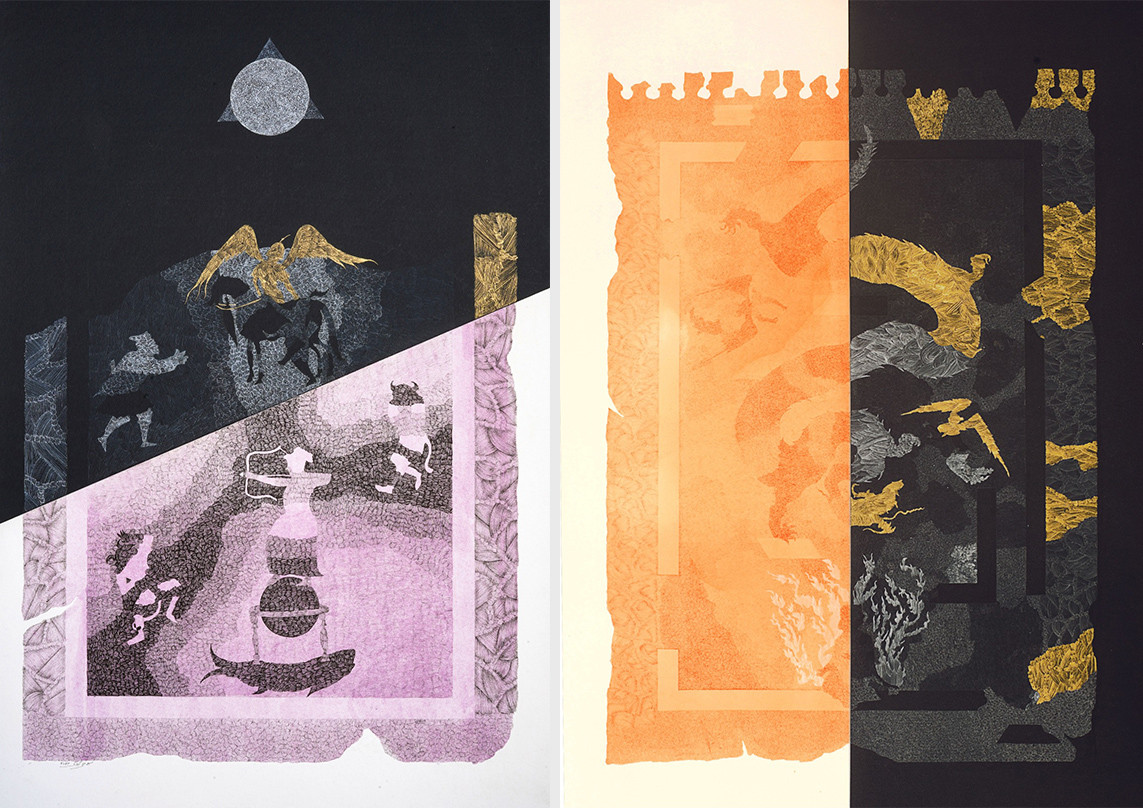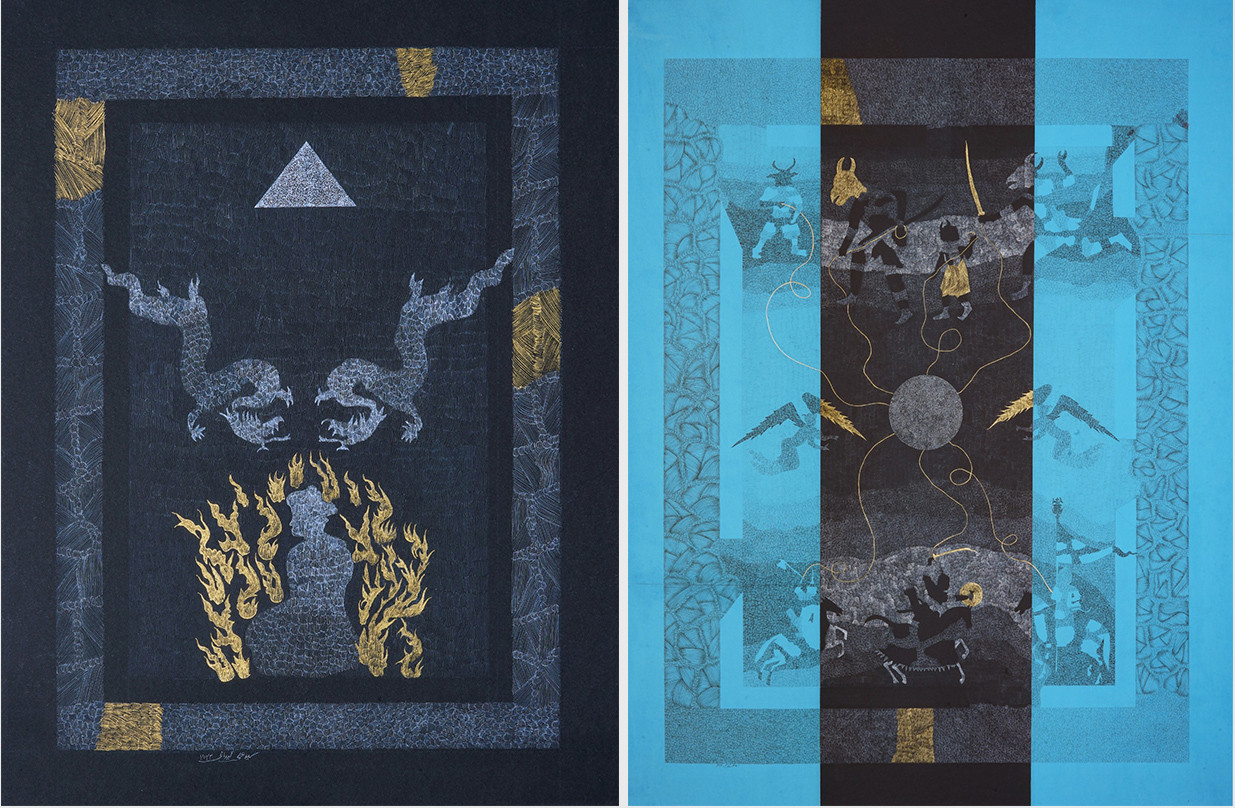The term' World-building' began in the 1800s and has a long history in science fiction. Referring to the process of constructing a rich, fictional universe, often with details like maps and characters with extensive bloodlines, it entered mainstream culture, according to Stewart Hicks (an architectural design educator), thanks to JRR Tolkien and Star Wars — weavers of epic multi-part stories within a single universe. On a September evening at Chawkandi Art Gallery, at the opening of Ali Gillani's Self and Cosmos, I spoke to the artist, and he gestured to this very concept.
Beautifully curated by Nusrat Khawaja, against the sepia walls of the gallery, Gillani's black and gold works shine and leap across time, oceans and realms. We are discussing how the artist's other career inflects his art practice. Gillani, in addition to being an extraordinary contemporary miniature painter (Nusrat says his "exquisitely rendered" paintings break "ground at a relatively young age", and he is represented by the acclaimed Sabrina Amrani Gallery in Spain), is also an art director and designer for a gaming company called Artductive. These two roles, one nourished by Ferdowsi's Shahnameh and training at the National College of Art, and the other, the world of animation and digital dance and meld in his paintings. His characters wrestle and reckon with dragons, phoenixes, the horned Karg from Shahnameh, swords and arrows, and their own demons. We are invited to the deepest interiors of the earth and the outermost celestial spheres.

The paintings are rendered with delicate mark-making, which can only be appreciated fully in person. In Gillani's opinion, some artists may conceive a painting as a concluded story. But his figures have past lives, and in works like ‘Patagonia’, an afterlife: a lifeless form is received by a winged creature to be carried to another realm, nearby a man kneels begging to be relieved of his suffering. Gillani weaves a complex tale in a single work; in the lower half are images from the 19th century "Jahangir Shoots Malik Ambar." As the emperor is resplendent atop a globe (an emphatic declaration of power and supremacy), we are reminded that heavy is the head that wears the crown.
In creating pieces for the show, Gillani said he began with the work' False Truth'. At 10 x 13 inches, this blue painting plants the seeds for the series' lyrical figures and exploration of "the nature of reality in which hierarchy, conflict, and the search for an authentic self are continuously engaging with and reconfiguring themselves within a cosmic framework" in the curator's words. In this small blue painting, two figures appear to be conjoined, one human, the other a beast, and are framed in a gold halo. The work points to humanity's relentless avarice and insatiable quest for gratification. In the sea below is a dragon; he is both a reflection in the water and a shadow. In the distance, there are creatures in the heavens. The painting discusses impermanence and false illusions of grandeur.
Nusrat says Gillani's figures are "reminiscent of martial arts scenes in iconic films such as Crouching Tiger Hidden Dragon, in which warriors seem to defy gravity in their choreographed swordfights." But perhaps more than that, his compositions are the stuff of Frank Miller's comics and cinema: landscapes with dramatic angles where villains and heroes dive and tumble among flames and peril. It is a world of high contrast and spectacle, and it is this universe that paintings like 'Pawns on a Chessboard' inhabit. Gillani slashes his surfaces in high contrast angles and a limited palette. His figures are faced with choices and straddle opposing realities. Gillani is fascinated by our forking paths: here is both the divine and the evil, dark and light, order and chaos. He uses the Taoist symbol of yin/yang, with its dual energies of feminine and masculine, as a point of departure. But one can read these works from many viewpoints. One can locate the hexagram used in Hinduism, its downward triangle, Shakti, for the feminine, and converse upward, Shiva, for the masculine, or the similar overlaid triangles of Judaism. In her curatorial note, Nusrat discusses this geometrical division as a form of "hybridism" where "the abstract geometry of these panels contrasts with narrative imagery. Abstraction and imagery create a complementary duality of two contrasting dynamics. The colour panels follow the logic of angular symmetries and are static, whereas the symbolic elements float in undefined spaces with an almost melodic rhythm." Characters like the horseman in 'Sacred Fight and Power' are unmoored from any system; armed with a golden bow, he seems to sail in the heavens, defiant in the face of a gleaming dragon. Gillani has a limited palette, and his paintings on a shadowy surface shimmer like dark oceans or skies.

In 'Undying Beliefs', the artist replaces mark-making with words. The painting has the heat of battle and the dust and chaos of a Karachi street. He gestures to the city's tumultuous past, snippets of violent headlines form the hashiya or border. Divided in two, the work is filled like a vessel, smoky violent scenes creating a murky residue. Images and text appear and recede, the words squabble for space. A demon and a golden phoenix sit at the top, as though in an unearthly sky. The demon drops a fiery rope into a pit, offering its wicked guidance to the receptive humans below. Gillani points to Karachi's challenges, where an 'undying demonic presence' always lurks as an undercurrent, whispering divisiveness and avarice.
Hailed as Pakistan's first home-grown art movement, the neo-miniature movement has given audiences a journey of exciting mutability. It is therefore a wonderful full circle, as noted by Amra Ali, that 'Self and Cosmos' is where it all began—the site of Pakistan's first contemporary miniature show held in 1997 and featuring young and fresh Imran Qureshi, Talha Rathore, Nusra Latif Qureshi, Sumaira Tazeen, Aisha Khalid, Fasihullah Ahsan and Amina Ali. Ali Gillani's straddling of two visual forms—the digital gaming encounters that envelop viewers physically and the pages of Ferdowsi's epic shows that new experiments are still brewing, and new universes await. It will be interesting to see him enhance his palette and stories; they will enrich the world he builds next.
Zehra Hamdani Mirza is a Karachi based writer and artist
All facts and information are the sole responsibility of the author
